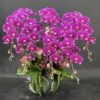# The Development of the Phalaenopsis Orchid Industry in Vietnam

The Phalaenopsis orchid, popularly known as Lan Hồ Điệp, has become a symbol of beauty and elegance worldwide. In Vietnam, the cultivation and trade of these stunning flowers have transformed into a significant industry, influencing local economies and agricultural practices. This article explores the development of the Phalaenopsis orchid industry in Vietnam, highlighting its historical background, cultivation techniques, economic impact, challenges faced, and future prospects.
## 1. Historical Background
### 1.1 Traditional Cultivation
The history of orchid cultivation in Vietnam can be traced back centuries. Orchids have been cherished for their beauty and fragrance, often used in traditional medicine and cultural practices. However, Phalaenopsis orchids, specifically, gained prominence in the late 20th century when Vietnamese farmers began to recognize their commercial potential.
### 1.2 The Emergence of the Phalaenopsis Orchid Industry
The 1990s marked a turning point for the Phalaenopsis orchid industry in Vietnam. As global demand for exotic flowers increased, Vietnamese farmers started experimenting with Phalaenopsis cultivation. With favorable climatic conditions, particularly in the southern regions like Ho Chi Minh City and the Mekong Delta, Vietnam emerged as a promising player in the international orchid market.
### 1.3 Government Support and Policies
Recognizing the economic potential of the orchid industry, the Vietnamese government implemented policies to support agricultural development. Initiatives included:
– **Investment in Research**: Government-funded research institutions began focusing on orchid cultivation techniques, pest management, and hybridization.
– **Training Programs**: Training programs were established for farmers, providing knowledge on modern cultivation practices and business management.
## 2. Cultivation Techniques
### 2.1 Growing Conditions
Phalaenopsis orchids thrive in warm, humid environments. The ideal conditions for their growth include:
– **Temperature**: Daytime temperatures between 25-30°C and nighttime temperatures around 18-22°C.
– **Humidity**: High humidity levels, ideally between 60-80%.
– **Light**: Indirect sunlight is preferred, with a light intensity of about 1,500 to 2,500 foot-candles.
### 2.2 Potting and Growing Media
Vietnamese growers utilize various potting media to cultivate Phalaenopsis orchids, including:
– **Bark Chips**: Commonly used due to their excellent drainage properties.
– **Sphagnum Moss**: Helps retain moisture while allowing airflow to the roots.
– **Coconut Coir**: An eco-friendly alternative that provides good aeration and moisture retention.
### 2.3 Watering and Fertilization
Proper watering and fertilization are crucial for healthy orchid growth:
– **Watering**: Phalaenopsis orchids prefer to dry slightly between waterings. Drip irrigation systems are often used for efficiency.
– **Fertilization**: A balanced fertilizer with an N-P-K ratio of 30-10-10 is typically applied every two weeks during the growing season.
### 2.4 Pest and Disease Management
Vietnamese growers face challenges with pests and diseases, which can affect orchid health. Integrated pest management (IPM) practices are adopted, including:
– **Regular Monitoring**: Farmers regularly inspect plants for signs of pests or disease.
– **Biological Control**: Introducing beneficial insects and using organic pesticides helps manage pest populations.
## 3. Economic Impact
### 3.1 Contribution to Local Economies
The Phalaenopsis orchid industry has significantly contributed to the economies of several regions in Vietnam:
– **Employment Opportunities**: The industry provides jobs for thousands of people, from cultivation to sales and export.
– **Income Generation**: Farmers engaged in orchid cultivation experience increased income compared to traditional crops, enhancing their standard of living.
### 3.2 Export Potential
Vietnam has become a key exporter of Phalaenopsis orchids, with major markets including the United States, Europe, and Japan. The export of orchids has been facilitated by:
– **Quality Standards**: Vietnamese growers have improved their production techniques to meet international quality standards.
– **Trade Agreements**: Vietnam’s participation in trade agreements has opened new markets for Vietnamese orchids.
### 3.3 Economic Statistics
According to recent reports, the Phalaenopsis orchid industry has generated significant revenue, contributing millions of dollars annually to the Vietnamese economy. The annual growth rate of the orchid industry has been impressive, averaging around 10-15% in recent years.
## 4. Challenges Faced by the Industry
Despite its growth, the Phalaenopsis orchid industry in Vietnam faces several challenges:
### 4.1 Climate Change
Changing climate patterns, including unpredictable weather events, can adversely affect orchid production. Growers must adapt to these changes through improved cultivation techniques and water management practices.
### 4.2 Competition
As the global orchid market expands, Vietnamese growers face increasing competition from countries like Thailand and the Netherlands. Differentiating their products and improving quality is essential for maintaining market share.
### 4.3 Pest and Disease Threats
Pests and diseases remain a significant concern for orchid growers. Continuous research and investment in pest management solutions are necessary to mitigate these threats.
### 4.4 Market Fluctuations
The orchid market can be volatile, with prices fluctuating based on supply and demand. Growers must be strategic in their production planning and marketing efforts to navigate these market dynamics.
## 5. Innovations and Future Prospects
### 5.1 Technological Advancements
The future of the Phalaenopsis orchid industry in Vietnam looks promising, with technological innovations playing a vital role:
– **Hydroponic Systems**: Some growers are adopting hydroponic systems for more efficient water and nutrient use.
– **Smart Farming Technologies**: The integration of smart technologies, including sensors and automated irrigation systems, helps optimize growing conditions and improve yield.
### 5.2 Sustainable Practices
Sustainability is becoming increasingly important in the orchid industry. Vietnamese growers are adopting environmentally friendly practices, such as:
– **Organic Fertilizers**: The use of organic fertilizers reduces environmental impact and appeals to eco-conscious consumers.
– **Waste Management**: Implementing waste management systems ensures that agricultural waste is recycled or disposed of responsibly.
### 5.3 Expanding Market Opportunities
With rising consumer interest in ornamental plants and flowers, the Phalaenopsis orchid market is poised for growth:
– **Online Sales**: E-commerce platforms are enabling growers to reach a broader audience and sell directly to consumers.
– **Diverse Product Offerings**: Innovating with hybrid varieties and unique colors can attract a wider customer base.
### 5.4 Education and Training
To ensure the continued success of the Phalaenopsis orchid industry, ongoing education and training for growers are crucial:
– **Workshops and Seminars**: Institutions and organizations can conduct workshops to share knowledge on best practices in orchid cultivation and marketing.
– **Collaboration with Research Institutions**: Partnerships with research institutions can facilitate innovation and improve growing techniques.
## 6. Conclusion
The Phalaenopsis orchid industry in Vietnam has witnessed remarkable growth over the past few decades, evolving from traditional cultivation practices to a thriving economic sector. With its significant contributions to local economies, export potential, and ongoing innovations, the industry is well-positioned for future success. By addressing challenges, embracing sustainability, and leveraging technological advancements, Vietnamese growers can continue to enhance the reputation of Lan Hồ Điệp on the global stage, ensuring its place as a symbol of beauty and elegance for generations to come.

